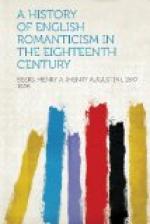“But many a fair shall
melt with woe
At thy soft strain
in future days,
And many a manly bosom glow,
Congenial to thy
lofty lays.”
These versions were all emitted in Scotland. But as late as 1814 “Fingal” appeared once more in verse, this time in London, and in a variety of meters by Mr. George Harvey; who, in his preface, expressed the hope that Walter Scott would feel moved to cast “Ossian” into the form of a metrical romance, like “Marmion” or “The Lay of the Last Minstrel.” The best English poem constructed from MacPherson is “The Six Bards of Ossian Versified,” by Sir Egerton Brydges (dated in 1784).[33] The passage selected was the one which Gray so greatly admired,[34] from a note to “Croma,” in the original “Fragments.” Six bards who have met at the hall of a chieftain, on an October night, go out one after another to observe the weather, and return to report their observations, each ending with the refrain “Receive me from the night, my friends.” The whole episode is singularly arresting, and carries a conviction of reality too often wanting in the epic portions of MacPherson’s collection.
Walpole, at first, was nearly as much charmed by the “Fragments” as Gray had been. He wrote to Dalrymple that they were real poetry, natural poetry, like the poetry of the East. He liked particularly the synonym for an echo—“son of the rock”; and in a later letter he said that all doubts which he might once have entertained as to their genuineness had disappeared. But Walpole’s literary judgments were notoriously capricious. In his subsequent correspondence with Mason and others, he became very contemptuous of MacPherson’s “cold skeleton of an epic poem, that is more insipid than ‘Leonidas.’” “Ossian,” he tells Mason, in a letter dated March, 1783, has become quite incredible to him; but Mrs. Montagu—the founder of the Blue Stocking Club—still “holds her feast of shells in her feather dressing-room.”
The Celtic Homer met with an even warmer welcome abroad than at home. He was rendered into French,[35] German, Italian, Spanish, Dutch, Polish, and possibly other languages. Bonaparte was a great lover of Ossian, and carried about with him a copy of Cesarotti’s Italian version. A resemblance has been fancied between MacPherson’s manner and the grandiloquent style of Bonaparte’s bulletins and dispatches.[36] In Germany Ossian naturally took most strongly. He was translated into hexameters by a Vienna Jesuit named Michael Denis[37] and produced many imitations. Herder gave three translations from “Ossian” in his “Stimmen der Voelker” (1778-79) and prefixed to the whole collection an essay “Ueber Ossian und die Lieder alter Voelker” written in 1773. Schiller was one of the converts; Klopstock and his circle called themselves “bards”; and an exclamatory and violent mannerism came into vogue, known in German literary history as Bardengebruell. MacPherson’s personal history need not be followed




